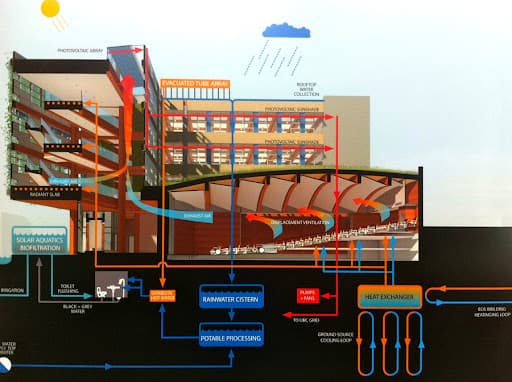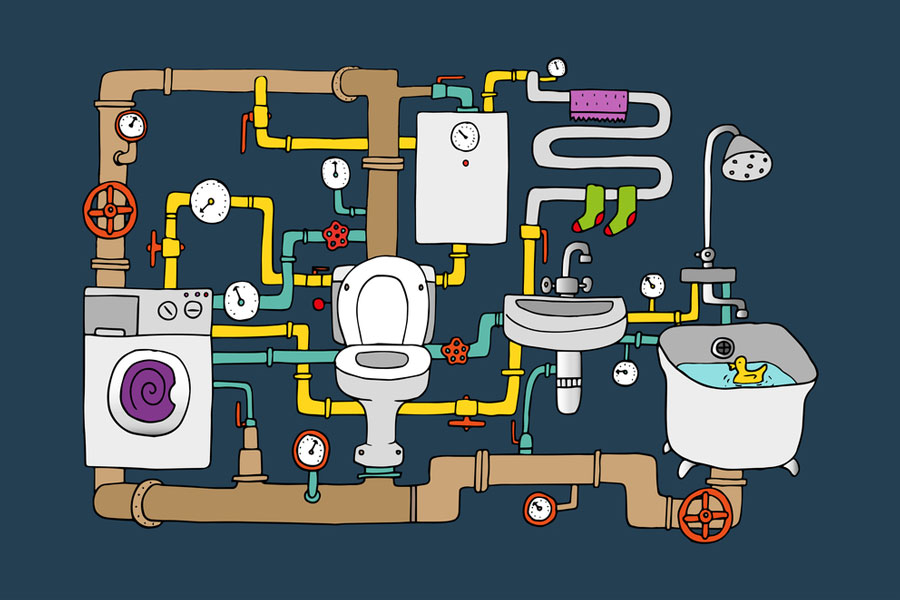On this page down the page you'll find more excellent additional info pertaining to The Inner Workings of Your Home's Plumbing.

Recognizing just how your home's plumbing system works is vital for every single homeowner. From supplying tidy water for alcohol consumption, food preparation, and bathing to safely eliminating wastewater, a properly maintained pipes system is crucial for your family's health and wellness and comfort. In this detailed overview, we'll check out the complex network that comprises your home's pipes and deal ideas on maintenance, upgrades, and taking care of usual concerns.
Intro
Your home's pipes system is greater than simply a network of pipelines; it's an intricate system that guarantees you have accessibility to tidy water and reliable wastewater elimination. Recognizing its parts and how they work together can aid you stop expensive repairs and ensure everything runs efficiently.
Standard Elements of a Pipes System
Pipelines and Tubing
At the heart of your plumbing system are the pipes and tubing that carry water throughout your home. These can be constructed from different materials such as copper, PVC, or PEX, each with its advantages in terms of longevity and cost-effectiveness.
Components: Sinks, Toilets, Showers, and so on.
Components like sinks, bathrooms, showers, and bathtubs are where water is used in your house. Recognizing just how these components link to the pipes system aids in identifying issues and intending upgrades.
Shutoffs and Shut-off Points
Valves manage the flow of water in your plumbing system. Shut-off shutoffs are vital during emergencies or when you require to make fixings, enabling you to isolate parts of the system without disrupting water circulation to the whole home.
Water Supply System
Key Water Line
The main water line attaches your home to the metropolitan water supply or an exclusive well. It's where water enters your home and is distributed to various components.
Water Meter and Stress Regulator
The water meter actions your water usage, while a stress regulatory authority ensures that water streams at a safe stress throughout your home's plumbing system, preventing damage to pipelines and fixtures.
Cold Water vs. Warm water Lines
Comprehending the distinction in between cold water lines, which supply water straight from the primary, and hot water lines, which bring heated water from the hot water heater, assists in troubleshooting and preparing for upgrades.
Drainage System
Drain Pipes Pipeline and Traps
Drain pipelines lug wastewater far from sinks, showers, and toilets to the sewage system or sewage-disposal tank. Catches stop sewer gases from entering your home and likewise trap particles that could create clogs.
Air flow Pipes
Air flow pipes allow air right into the water drainage system, avoiding suction that can slow down water drainage and trigger catches to empty. Correct ventilation is necessary for maintaining the stability of your plumbing system.
Value of Correct Drain
Making certain proper drainage stops back-ups and water damages. Frequently cleansing drains and preserving catches can avoid pricey repairs and prolong the life of your pipes system.
Water Heating System
Kinds Of Water Heaters
Hot water heater can be tankless or conventional tank-style. Tankless heating systems warm water as needed, while storage tanks store warmed water for prompt use.
Upgrading Your Pipes System
Factors for Upgrading
Updating to water-efficient fixtures or replacing old pipelines can boost water quality, minimize water costs, and increase the worth of your home.
Modern Pipes Technologies and Their Advantages
Explore technologies like wise leakage detectors, water-saving commodes, and energy-efficient water heaters that can save money and minimize ecological impact.
Cost Considerations and ROI
Determine the ahead of time prices versus long-lasting savings when thinking about pipes upgrades. Lots of upgrades spend for themselves via reduced utility expenses and fewer repair services.
Just How Water Heaters Attach to the Plumbing System
Understanding how water heaters link to both the cold water supply and hot water circulation lines assists in diagnosing concerns like not enough warm water or leakages.
Upkeep Tips for Water Heaters
Regularly flushing your water heater to remove sediment, checking the temperature settings, and inspecting for leaks can extend its lifespan and improve energy efficiency.
Typical Plumbing Issues
Leaks and Their Reasons
Leakages can take place as a result of maturing pipelines, loosened installations, or high water pressure. Dealing with leaks promptly prevents water damages and mold and mildew development.
Blockages and Clogs
Clogs in drains and toilets are commonly brought on by purging non-flushable things or a build-up of oil and hair. Making use of drainpipe displays and being mindful of what drops your drains pipes can avoid clogs.
Signs of Pipes Troubles to Watch For
Low water pressure, slow-moving drains pipes, foul odors, or uncommonly high water bills are signs of possible pipes issues that ought to be addressed without delay.
Pipes Maintenance Tips
Regular Examinations and Checks
Arrange annual pipes inspections to catch issues early. Seek indications of leaks, deterioration, or mineral accumulation in faucets and showerheads.
DIY Upkeep Tasks
Basic tasks like cleansing tap aerators, checking for commode leaks using color tablets, or protecting revealed pipes in cold environments can avoid significant plumbing issues.
When to Call a Specialist Plumbing
Know when a plumbing issue calls for expert know-how. Trying complex repairs without appropriate understanding can cause even more damages and greater repair work prices.
Tips for Decreasing Water Usage
Simple habits like repairing leaks immediately, taking much shorter showers, and running full loads of washing and meals can preserve water and lower your energy bills.
Eco-Friendly Pipes Options
Take into consideration sustainable pipes products like bamboo for flooring, which is durable and eco-friendly, or recycled glass for countertops.
Emergency situation Preparedness
Steps to Take Throughout a Plumbing Emergency
Know where your shut-off shutoffs lie and how to shut off the water supply in case of a burst pipeline or major leak.
Relevance of Having Emergency Get In Touches With Convenient
Keep get in touch with details for local plumbing technicians or emergency situation solutions readily available for fast response during a pipes crisis.
Environmental Influence and Preservation
Water-Saving Fixtures and Home Appliances
Mounting low-flow taps, showerheads, and toilets can substantially lower water use without sacrificing performance.
Do It Yourself Emergency Situation Fixes (When Applicable).
Short-term repairs like making use of air duct tape to spot a leaking pipe or putting a container under a trickling tap can minimize damage up until an expert plumbing professional arrives.
Conclusion.
Recognizing the makeup of your home's plumbing system empowers you to keep it properly, conserving money and time on repairs. By following regular maintenance routines and staying notified regarding contemporary plumbing technologies, you can guarantee your pipes system runs successfully for several years ahead.
HOW YOUR PLUMBING SYSTEM WORKS
Which Pipes Do What?
- Blue lines = fresh water supply entering the building
- Red lines = hot water supply entering the building
- Grey lines = pipes carrying waste away from the building and venting pipes carrying gases away from the building (through the roof)
YOUR MAIN PLUMBING SYSTEMS
There are two main plumbing systems that support your home s basic plumbing needs one that brings clean water into your home, and one that sends dirty water away from your home. Connected to the toilet, bath, shower, and other faucets in your home, these two systems keep your water flowing in the right directions.
ACCESSING FRESH WATER
Fresh and clean water is brought into your home through the main water supply line . Filtered through one pipe, this water is pressured to flow into the various fixtures in your home at any given time.
This water can be sourced from a well located on your property, a pond or river (mostly cottages), or, as in most cases, from the city s municipal water treatment centre. However, it is important to note that water that is untreated, such as the water siphoned from ponds or rivers, may not be safe to drink. Personal water supplies always need to be treated for hardness and contaminants before consumed.
MUNICIPAL WATER SUPPLIES
- Improve taste and odour
- Remove sediment
- Eliminate hardness
- Reduce chlorine
COLD WATER SUPPLY VS. HOT WATER SUPPLY
Cold water flows into your home or building through the service line, which then distributes hot or cold water to your fixtures. This line is most commonly run through a central column that runs floor to floor. Hot water runs in short and straight pipes as the longer the pipeline, the more heat that will be lost in the transfer. Having shorter pipes also allows residents to access hot water more quickly.
WASTE WATER SYSTEM
Your wastewater system is divided into two parts pipes that send wastewater away from your home and venting pipes that send sewer gas away from your home. Sewage water travels through pipes that flush the water and waste towards local sewers that are operated and managed by your city or town. Most sewer systems rely on gravity to move the wastewater to where it needs to go.
The further away from your toilet or sink, the larger wastewater pipes become. This allows for waste to be disposed of from various parts of your home or business at once without pipe blockages. The angle and flow of these pipes are also essential for keeping your waste pipes clear of build up.
https://harrisplumbing.ca/how-your-home-plumbing-system-works/

We hope you enjoyed our article about . Many thanks for finding the time to read our post. Don't hesitate to pause to promote this article if you appreciated it. Many thanks for going through it.
Schedule Your Job Now
Comments on “The Design of Your Home's Plumbing System Explained”